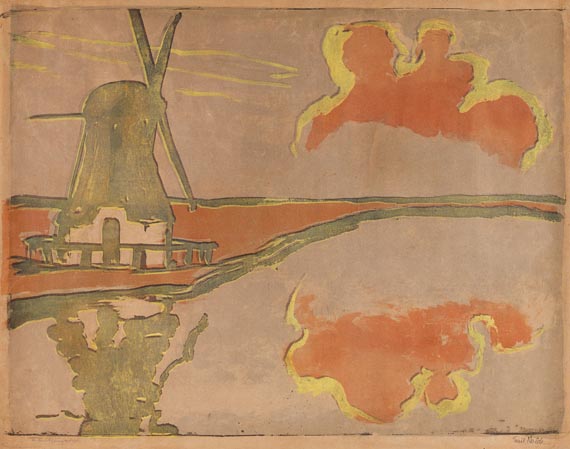
60
Emil Nolde
Mühle am Wasser, 1926.
Lithograph in colours
Estimate:
€ 38,000 / $ 40,660 Sold:
€ 46,360 / $ 49,605 (incl. surcharge)
Lithograph in colors
Schiefler/Mosel L 82. Signed lower right. Inscribed in pencil "In dieser Fassung ein Druck" in lower left, presumably by a hand other than that of the artist. On delicate paper. 60,3 x 79 cm (23,7 x 31,1 in)Sheet: 64,5 x 80,5 cm (25,3 x 31,6 in).
Only print in this coloring.
Emil Hansen was born near the German-Danish border on 7 August 1867. He adopted the name of his birth town as his artist name at a later date. Nolde completed an apprenticeship as a furniture designer and wood carver in Flensburg between 1884 and 1888 and then worked for various furniture factories in Munich, Karlsruhe and Berlin. He was employed as a teacher of industrial drawing at the Gewerbemuseum (Industrial Museum) in St. Gallen in 1892, where he taught until 1898. There, where at first mainly landscape watercolors and drawings of mountain farmers emerged, Nolde became known through small colored drawings of Swiss mountains. Nolde finally moved to Munich after deciding to become a painter, but the academy under Franz von Stuck dismissed him. He joined Adolf Hölzel in Dachau and went to Paris in 1899 to increase his knowledge at the Académie Julien. In 1900 he rented a studio in Copenhagen and moved to the island of Alsen in 1903. Nolde studied the Neo-Impressionists Vincent van Gogh, Edvard Munch and James Ensor, which, around 1905, gradually led him away from his early Romantic Naturalism and to the discovery of his own style with a strong emphasis on color, colorful and glowing flower pictures came into existence. During a sojourn in Alsen in 1906 Nolde met the painters of 'Die Brücke', a group he joined briefly in the same year. A series of portrait studies marked the artists discovery of the watercolor. Nolde's first attempts in 1909 at painting in this technique on non-absorbent paper, leaving large areas of the paper uncovered and dispensing with contours, were quite revolutionary. After a dispute with Max Liebermann, Nolde was excluded from the 'Berlin Secession' and founded together with other dismissed artists the 'New Secession' in 1910 and participated in their exhibition until 1912. Less fascinated by the city-life of Berlin, which he recorded in expressionistic pictures, than by primitivism, Nolde painted still lives with exotic figures and mask pictures. He returned from an expedition to New Guinea in 1913 with lots of study material, which he worked up in numerous works until 1915. Since 1916, he spent his summers on the island Föhr.
In 1907 Emil Nolde began to examine the medium of lithography. A highlight of his graphic œuvre are his large-size lithographs in colors, which were first made in 1913, but also years later around 1926. Printed in small editions, usually just few copies and single trial proofs, these works are among the best accomplishments of expressionist print art. Nolde and his quest for experimental ways of expressing his art seem to perfectly benefit from the lithography technique: "As it was often the case, I also used to put drawings, which I had executed with fat India ink on paper, onto the stone, in doing so the stone appeared to me as nothing but a cheap means of reproduction. It is only when the artist gets to work on the stone itself that he experiences the technique’s appeal and its far reaching possibilities." (Emil Nolde, Mein Leben, Cologne 1976, 8\up5 th edition 1990, p. 225).
He settled in Seebüll in 1928. The garden in Seebüll became an unfailing source of inspiration for his painting, but also coast areas and religious scenes became his primary subjects. Defamed during the war and banned from exhibiting his works since 1941, Nolde spent the years 1939 to 1945 in Seebüll painting his 'unpainted paintings', hundreds of small watercolors, which he took on in his oil paintings after 1945. In his last years, primarily watercolors with flower and landscape motifs from the neighborhood of his house in Seebüll, where Nolde died on 13 April 1956, came into existence. [CM].
60
Emil Nolde
Mühle am Wasser, 1926.
Lithograph in colours
Estimate:
€ 38,000 / $ 40,660 Sold:
€ 46,360 / $ 49,605 (incl. surcharge)




 Lot 60
Lot 60 